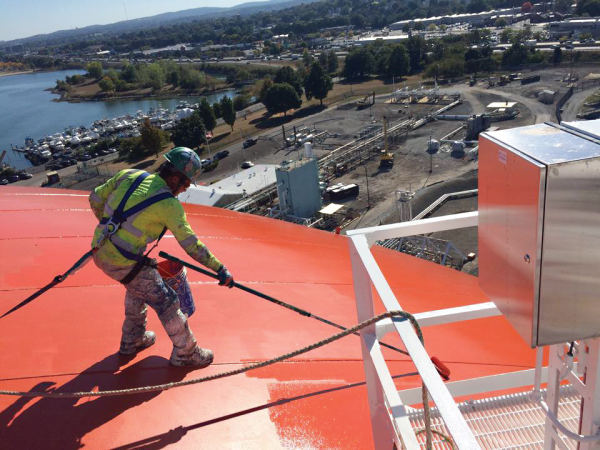October 30, 2014

Julian Escondon, a union painter for the John W. Egan Company, worked on the top of the National Grid rainbow gas tank last month. John Doherty photo
A team of union painters have just completed a four-month project to re-paint the National Grid gas tank on Dorchester Bay. The workers for the John W. Egan company — all members of the Painters District Council 35 based in Roslindale— touched up fading swatches of Corita Kent’s iconic rainbow design, which remains the largest copy-written piece of art in the world.
The painters worked from platforms suspended from the tank’s roof— 14 stories above the ground. The paint job took slightly longer than expected because of weather and other conditions, including condensation that forms in the morning and evening on the exterior of the tank, which stores liquefied natural gas (LNG).
Kent, a Catholic nun and famed artist who died in 1986, was commissioned to design the rainbow tank by the Boston Gas Company in 1971. At the time, two LNG tanks stood on Commerical Point. When the original rainbow tank was dismantled in 1992, Kent’s design was transferred onto the second tank by workers from the Egan Company, which specializes in painting landmarks. The company recently painted the dome of the State House, Governor Deval Patrick’s renovated office and the replica Senate chamber inside the newly constructed Edward M. Kennedy Institute for the US Senate on Columbia Point.
The rainbow tank, though, presents a special challenge to the union painters, according to Robert Belisle, Jr., the project manager from the Egan Company.
“Because of how intricate the design was and the amount of eyes on it, it makes it more complicated. There’s no more pressure than on another job, but I guess if we –screwed it up somebody’s going to notice.”
The workers used swing staging— identical to what window-washers use to clean the sides of skyscrapers— but retrofitted to use different anchor points on the top of the tank. Three foot wide, thirty feet long platforms have handrails around it and an air hoist on each to lower and raise the workers, each of whom has a separate safety line strapped to their body.
The sides of the tank need to be re-painted— or at least touched up— every ten years, according to Belisle. The roof, he says, need even more frequent attention.
“The roof, because it takes so much direct light and acid rain and snow and everything else, that’s probably every 5 to 7 years,” said Belisle.
This year’s work was “pretty involved,” said Belisle.
“The design was pretty faded and starting to chip off, especially after we power-washed it. We then applied a five coat system and hit it with a coat of epoxy and a full coat of clear eurathayne,” he said.
Back in June, the workers removed a large decal with the National Grid logo before starting their work. The decal— which Belisle compared to a “giant piece of duct tape”— had been adhered to the tank after National Grid took ownership of the landmark facility in 2007. For a time, before the John W. Egan crew painted over it,
the tank once again sported its old-school Boston Gas logo.
The job is a high-profile one for the painters’ union, said John Doherty, a Dorchester native who helps to organize for Painters DC35, which helps to train and certify signatory contractors like the Egan Company.
“We take pride in giving back to Dorchester,” said Doherty, who says that the union recently completed donated paint projects at the Mather School and St. Mary’s Church on Jones Hill.
“These guys do all commercial, industrial work and a lot of landmarks, like the Custom House. This one is one of the biggest, though and everyone gets the back story,” said Doherty.
Villages:


